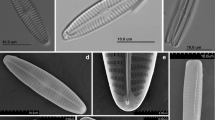Abstract
Two tubificid oligochaetes, Branchiura sowerbyi and Tubifex tubifex, were evaluated as potential test organisms for sediment bioassays. We attempt to reproduce the sediment bioassay proposed by Reynoldson et al. (1991) using his strain of Tubifex tubifex and his reference sediment and to compare this technique using Branchiura sowerbyi. This species was chosen because it is more common and dominant in tropical and subtropical environments than Tubifex tubifex. Data on survival and reproduction were obtained for both species, and growth estimates were obtained for B. sowerbyi. The sublethal bioassay with T. tubifex confirmed earlier estimates of a test duration of 4 weeks at 22.5 °C. B. sowerbyi cultures can produce usable estimates in 21 days at 30 °C.
Similar content being viewed by others
References
Ankley, G. T., G. L. Phipps, E. N. Leonard, D. A. Benoit, V. R. Mattson, P. A. Kosian, A. M. Cotter, J. R., Dierkes, D. J. Hansen & J. D. Mahony, 1991. Acid-volatile sulfide as a factor mediating cadmium and nickel bioavailability in contaminated sediments. Envir. Toxicol. Chem. 10: 1299–1307.
Aston, R. J., 1968. The effect of temperature on the life cycle, growth and fecundity of Branchiura sowerbyi (Oligochaeta: Tubificidae). J. Zool. Lond. 154: 29–40.
Aston, R. J. & A. G. P. Milner, 1981. Conditions required for the culture of Branchiura sowerbyi (Oligochaeta: Tubificidae) in activated sludge. Aquaculture 26: 155–160.
Aston, R. J., K. Sadler & A. G. P. Milner, 1982. The effect of temperature on the culture of Branchiura sowerbyi (Oligochaeta:Tubificidae) on activated sludge. Aquaculture 29: 137–145.
Buikema, A. L., Jr., B. R. Niederlehner & J. Cairns, Jr., 1982. Biological monitoring. Part IV Toxicity testing. Wat. Res. 16: 239–262.
Buikema, A. L., Jr. & J. R. Voshell, Jr., 1993. Toxicity studies using freshwater benthic macroinvertebrates. In D. M. Rosenberg & V.H. Resh (eds), Freshwater Biomonitoring and Benthic Macroinvertebrates, 344–398. Chapman & Hall, N.Y.
Casellato, S. & P. Negrisolo, 1989. Acute and chronic effects of an anionic surfactant on some freshwater tubificid species. Hydrobiologia 180: 243–252.
Chapman, P. M., M. O. Farrell & R. O. Brinkhurst, 1982a. Relative tolerances of selected aquatic oligochaetes to combinations of pollutants and environmental factors. Aquat. Toxicol. 2: 47–67.
Chapman, P. M., M. O. Farrell & R. O. Brinkhurst, 1982b. Relative tolerances of selected aquatic oligochaetes to individual pollutants and environmental factors. Aquat. Toxicol. 2: 69–78.
Dermott, R. & M. Munawar, 1992. A simple and sensitive assay for evaluation of sediment toxicity using Lumbriculus variegatus. Hydrobiologia 235/236: 407–414.
Finogenova, N. P. & T. M. Lobasheva, 1987. Growth of Tubifex tubifex Muller (Oligochaeta, Tubificidae) under various trophic conditions. Int. Revue ges. Hydrobiol. 72: 700–726.
Kosiorek, D., 1974. Development cycle of Tubifex tubifex Muller in experimental culture. Pol. Arch. Hydrobiol. 21: 411–422.
Marchese, M. R., 1988. New record of the blanchardi form of Tubifex tubifex (Muller, 1774) (Oligochaeta, Tubificidae) in Argentina and its relationship to suggested synonymous species. Physis 46: 55–58.
Milbrink, G., 1987. Biological characterization of sediments by standardized tubificid bioassays. Hydrobiologia 155: 267–275.
Paoletti, A., 1989. Cohort cultures of Tubifex tubifex forms. Hydrobiologia 180: 143–150.
Phipps, G. L., G. T. Ankley, D. A. Benoit & V. R. Mattson, 1993. Use of the aquatic oligochaete Lumbriculus variegatus for assessing the toxicity and bioaccumulation of sediment-associated contaminants. Envir. Toxicol. Chem. 12:269–279.
Reynoldson, T. B., 1987. The role of environmental factors in the ecology of tubificid oligochaetes. An experimental study. Holarct. Ecol. 10: 241–248.
Reynoldson, T. B., S. P. Thompson & J. L. Bamsey, 1991. A sediment bioassay using the tubificid oligochaete worm Tubifex tubifex. Envir. Toxicol. Chem. 10: 1061–1072.
Varela, M. E., J. A. Bechara & N. Andreani, 1986. El macrobentos y su relación con las fluctuaciones de salinidad en ríos y esteros del Chaco Oriental (Argentina). Ambiente subtropical 1: 134–147.
Wiedenbrug, S., 1993. Aspectos da estrutura espacial da macrofauna béntica da Lagoa Emboaba, R.S. Tesis. Universidade Federal do Río Grande do Sul, 157 pp.
Wiederholm, T., A. Wiederholm & G. Milbrink, 1987. Bulk sediment bioassays with five species of fresh-water oligochaetes. Wat. Air Soil Pollut. 36: 131–154.
Author information
Authors and Affiliations
Rights and permissions
About this article
Cite this article
Marchese, M.R., Brinkhurst, R.O. A comparison of two tubificid oligochaete species as candidates for sublethal bioassay tests relevant to subtropical and tropical regions. Hydrobiologia 334, 163–168 (1996). https://doi.org/10.1007/BF00017366
Issue Date:
DOI: https://doi.org/10.1007/BF00017366




